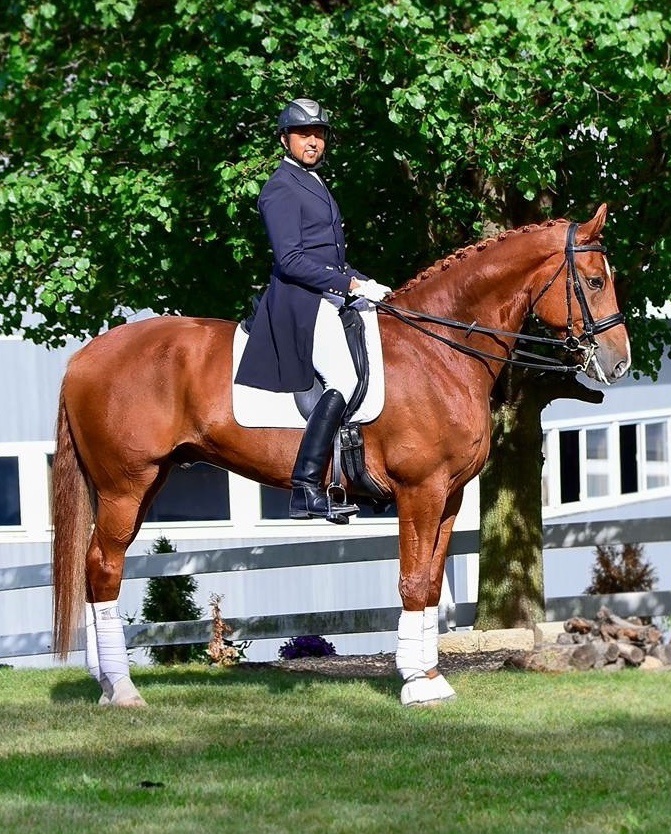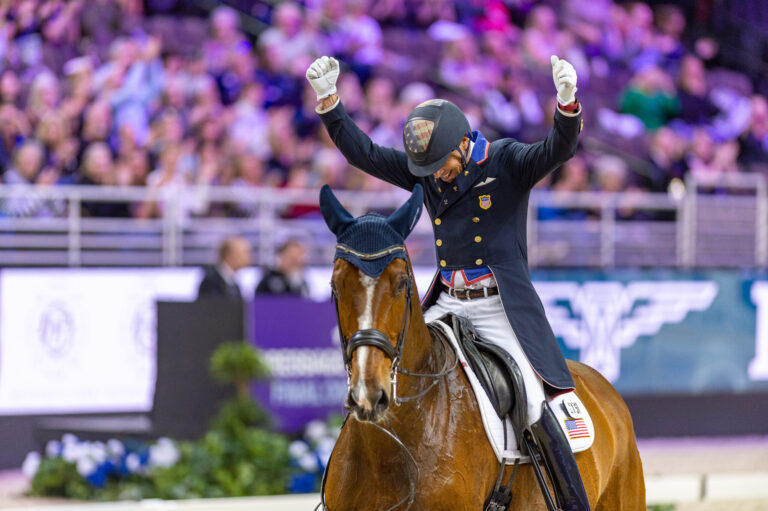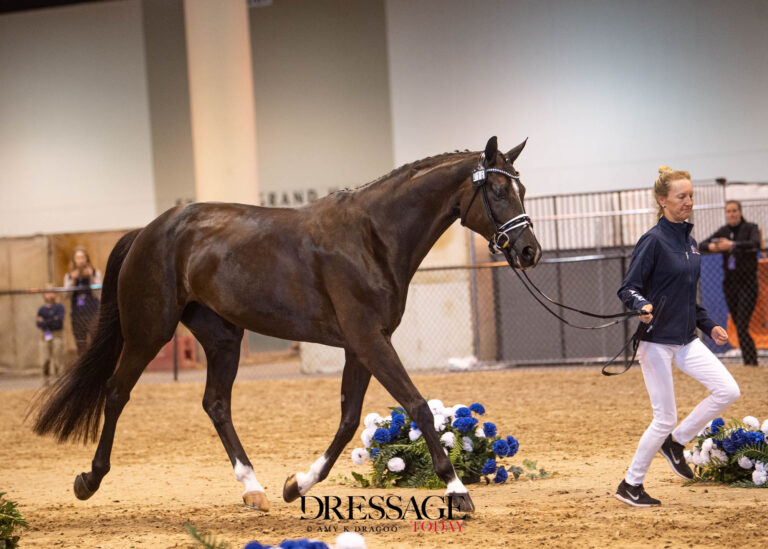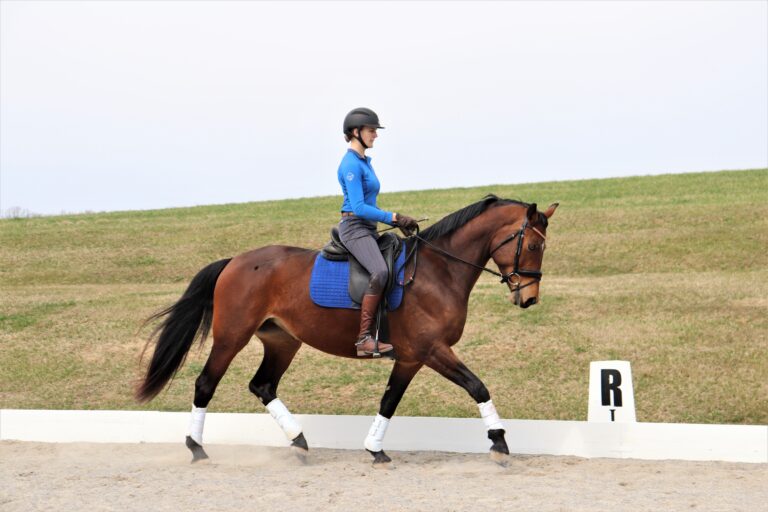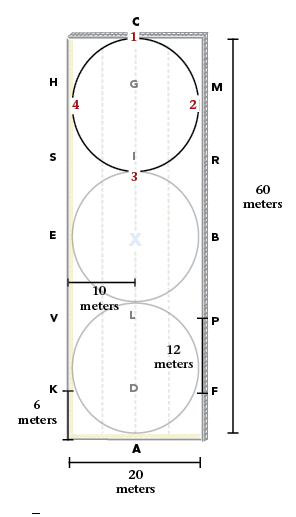Matt McLaughlin began studying dressage and the art of training horses in haute école, advanced classical dressage featuring airs above the ground, for exhibition performances at a young age. He credits his early dressage influence on U.S. Dressage Federation Hall of Fame member Chuck Grant. McLaughin then spent seven years working for the Royal Lipizzaner Stallion Show in Las Vegas, Nevada.
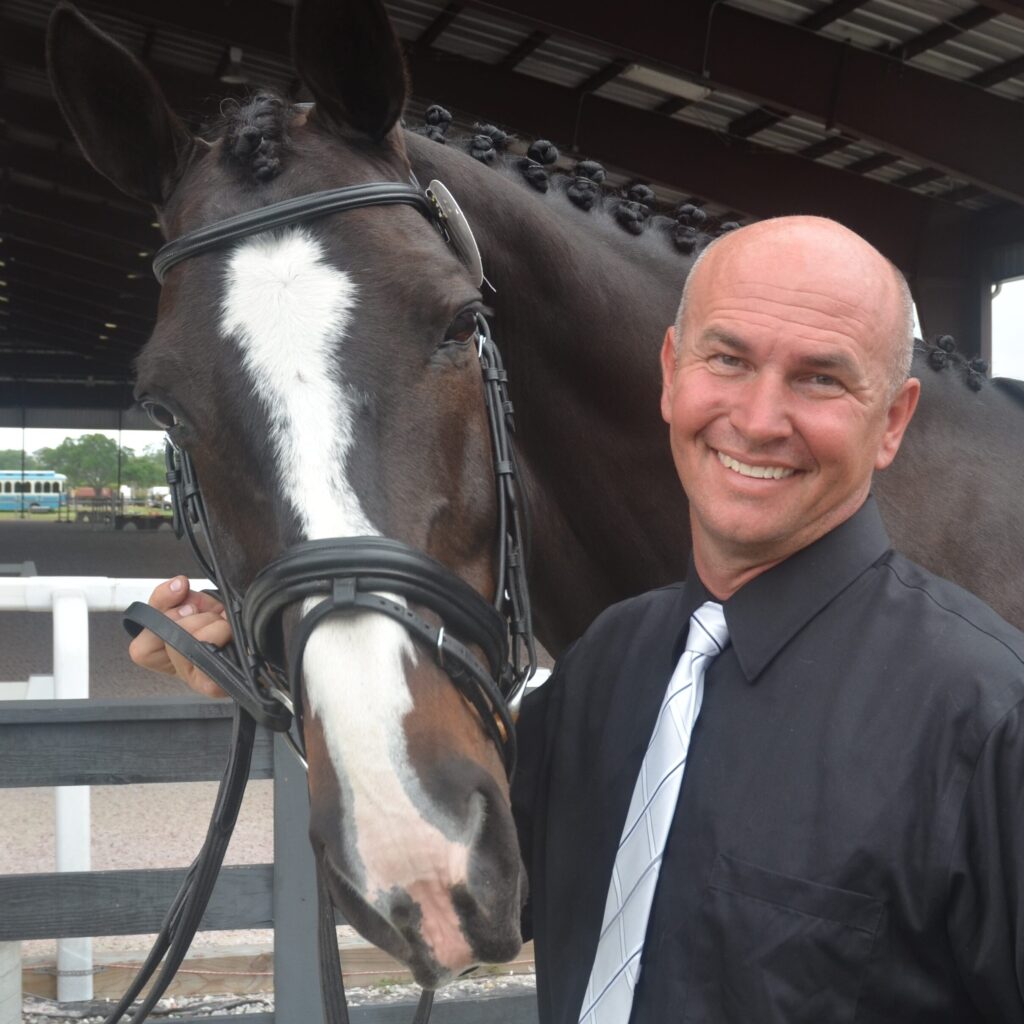
© Heather Black
In 2011, McLaughlin was head trainer at the Arabian Nights Dinner Theater in Orlando, Florida, where he restructured the equestrian production’s dressage, liberty, Western and reining acts. McLaughin has continued to hone his skills as a trainer, clinician and performer by learning and adapting techniques gleaned from training experiences, as well as his work with industry notables in the dressage, Western and trick training disciplines.
McLaughlin has successfully trained horses through Grand Prix dressage that have gone on to compete nationally and internationally, as well as multiple horses finished in haute école, including capriole, courbette and levade. He has earned the USDF bronze, silver and gold rider medals and is a “r” judge. He provides instruction at his base in St. Cloud, Florida, and travels throughout North America and Europe as a clinician.
Here McLaughlin shares more about his background, training horses for entertainment compared to classical dressage and characteristics he likes in horses.
The Early Days
Dressage Today: Tell us how you got started in horses and then specifically in dressage?
Matt McLaughlin: I was born and raised in Pennsylvania. I think my aunt put me on my first horse. She used to ride hunters and still does. I want to say she’s probably close to 70 now. I think I was 4 years old, and I loved it. Then I got my first horse myself when I was 10 and did the normal 4-H and local hunters. And that slowly transitioned into eventing and also exercising racehorses when I was a teenager.
I got in a car accident when I was 17. My mom and I were on the way home from the barn and got hit by a drunk driver. It was nothing major, but it was still a misalignment of my atlas and axis. I was starting to jump much bigger fences, and I would get migraines. So, the doctors said I couldn’t jump for a year.
I was lucky enough to become a working student for Chuck Grant, who was in Michigan at the time. Grant is a USDF Hall of Fame member. He was sort of the father of dressage in this country. I was with him for about a year and a half.
DT: You mentioned Chuck Grant. Who else influenced your riding over the years?
MM: I was always lucky enough to have the gift of being able to interact well with people. There weren’t specific ones that I would put as absolute influences like Chuck. There were riders from the Spanish Riding School who would come over and do clinics. There’s no one specific, but a very well-rounded experience. And I’ve had friends from reining and cutting disciplines. Maybe they don’t apply directly to dressage, but there’s something from each that you can implement in the training of horses. I’m a big one on good horsemanship is good horsemanship.
The Entertainment Industry
DT: How did you get involved with the Royal Lipizzaner show?
MM: I was offered a job when I was a working student with Chuck Grant when I was 18. At that time, I didn’t think I was ready for it. And then at 23, they offered me a job again, and it sounded great going to Las Vegas at age 23.
The show we had in Vegas was where we did all the training at that time. They did not have the training facility in Florida that they built a bit later. We had probably had close to 50 horses there.
I started in 1992, and I was with them until the end of 1997. The business was sold, and within a year or so they went bankrupt. The old owners restarted the show in 1999, so I came back and helped them get going. My business partner, Lori Beggs, was working for them full time in Florida, so I was back and forth between Las Vegas and Florida probably a total of seven to nine years.
DT: What’s it like going back and forth from something that’s pretty much entertainment and training and competing classical dressage?
MM: I was more based in the competitive background (with Grant), but that’s where I started to learn how to train all the haute école and the tricks from him. Then I learned the airs above the ground movements as I worked for the show and with a few Austrians.
When I left the Lipizzaner show, it became more about competition, even though I started to get into horse expos. I’d get hired to be a dressage demonstrator, but then I’d have my exhibition horses performing in the evening shows. But all during that, the tricks were secondary to me. It was more about the competitive dressage.
DT: How did you get involved with Arabian Nights Dinner Theater?
MM: They approached me. I had known the owners, and the owner’s daughter hired me. She wanted to bring her vision for the show. It was still entertaining and trick based, but she also wanted the horsemanship to start coming up more and more. Right when I started, she ended up leaving, and then I was working with her dad. He was still a little bit more into the pure entertainment end of it. I never rode in the Arabian Nights show. I was their head trainer and worried about training the horses and the riders.
Entertainment Training and Classical Dressage Training
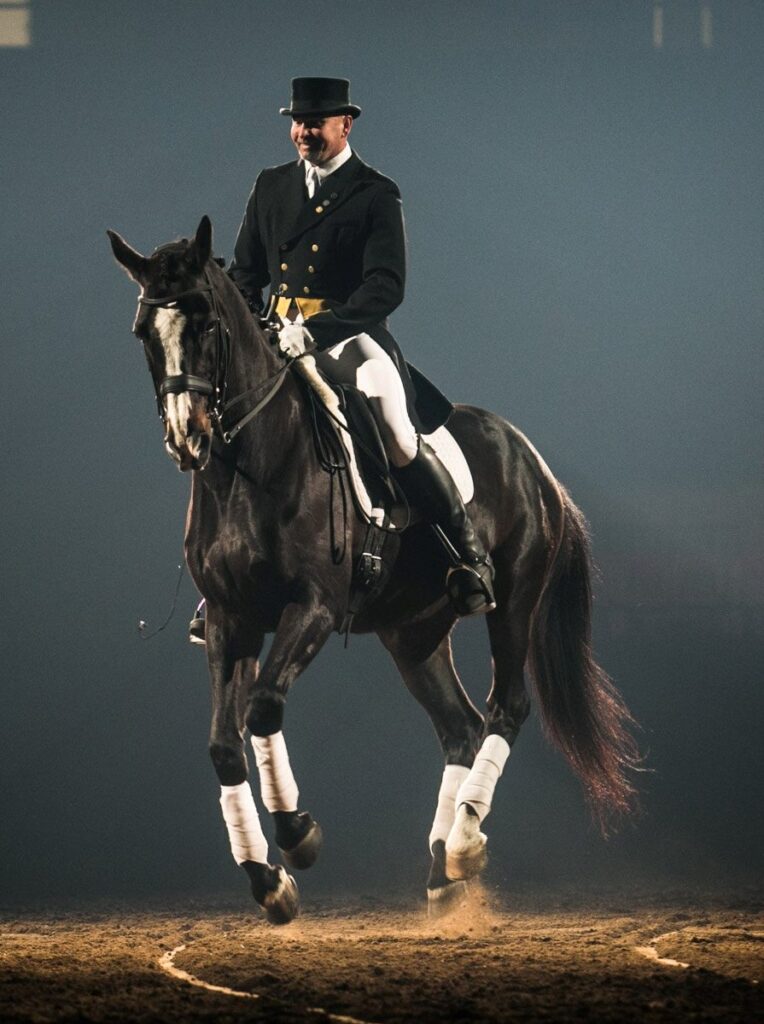
Photo courtesy of Matt McLaughin.
DT: You’ve done a lot of different programs. How has the entertainment portion influenced, or has it influenced, the traditional dressage training?
MM: If there’s any influence, at least from a training standpoint, it’s that there are many ways to train. There’s way too much focus on, “You can only do something one way, and this horse can’t do that because it doesn’t show the talent for it.” I’m a big believer, just like Chuck Grant was, that most horses can do Grand Prix. Are they going to go compete at the Olympics? No, but they can do most of the work.
DT: I would imagine the entertainment part of it is a great way to desensitize horses as well.
MM: It really was. When I used to do the horse expos, I always took a young horse with me. And that was so fantastic. Some events had over a thousand horses. Those young horses would come home from that and be like “I don’t care about a flower box.”
I’m a big believer that traditional, classical dressage was training horses for war, so they could not spook when somebody’s running at you. We’ve lost focus on that. Now, to be fair, the horses are so much hotter and more electric than they were back then, but nonetheless, that’s all still a degree of training. I don’t let my young horses go to strange places and just willy-nilly look outside the arena. They must stay focused. The work is in the middle of the arena. That’s where I’m focused. That’s where they stay focused.
DT: Do you find that your training methods bounce back and forth from the techniques used in the entertainment business to classical and back again, depending on the kind of horse that you’re working with or the rider that you’re working with?
MM: I wouldn’t say they bounce back with the tricks so much, but I’m a big believer in correct groundwork and rope halter work. Those are techniques that apply to any discipline. It’s about learning a technique of teaching the horse to move away from your body.
It’s about real horse psychology, and that means that you’re a fair leader, but you’re the leader of the herd, and the horses must look to you for direction. I think of natural horsemanship as being an offshoot of what good liberty training used to be. And I’m always shifting back and forth, especially with horses that have focus issues. It’s about getting the horse to respect you as the leader and to move his feet in the correct way and the groundwork that people don’t do because all they want to do is ride.
We were known for taking problem horses, but that’s kind of shifted after I had my sacrum and my pelvis broken by a young horse four years ago. I’m also older and I’m slower, so I don’t take problem horses that I’m going to fix under-saddle. I will take them and do long-lining with them. I am an enormous proponent of long-lining, and I fix most of my problem horses on long-lines.
Then the owner has to supply me with the rider, whether it’s them or somebody else, who’s going to make the transition of everything that’s installed, so to speak, from long-lines. They’re going to be different horses, but then we must teach the riders how to interact with them differently. Otherwise, they’re just going to revert again.
Understanding the Horse
DT: Do you have a kind of horse that you prefer to ride?
MM: I love Iberians. I love Andalusians and Lusitanos. But I hate going down the route of saying there’s one specific horse. I just had a Lipizzaner here. I’ve got an Irish draft and quite a few warmbloods. I’ve worked with Friesians, and a client’s looking for a Gypsy Vanner. My favorite horse right now is a Lusitano that I’ve had in training since he was 3-1/2. He’s the ultimate horse to train. He’s so easy to work with.
DT: What characteristics in a horse do you like?
MM: The brain. I absolutely love horses that I don’t constantly worry about. I do like a hotter horse and a stronger horse in my hand. When you have a brain that can instantly catch themselves, that’s so nice to work with.
DT: You’re involved in a lot of different things and in a lot of different ways. You’re judging, you’re training, you’re doing all sorts of things. How do you manage it all?
MM: The person I miss the most right now is my business partner Heather, but she’s not really part of the business anymore. She kept me so organized, but that’s because she’s extremely organized. Now, my girlfriend Carly is very organized. And honestly, I kind of rely on them. Then the business partner who’s with me here in Florida, Lori Beggs, she really keeps the farm running. I never have to worry about the horses being taken care of. So that’s it. Be surrounded by a team that you can trust or at least one person that you can rely on.
DT: What do you enjoy that’s outside of the horse world?
MM: I do everything you can imagine with vintage race cars. My best friend and I build and race vintage cars together. I’ve got a 2,000 square foot shop that has an old Mustang in it right now. And I have a friend who restores Shelbys. Everything, when I’m not with horses, it’s horsepower.
What Makes a Great Horseperson
DT: What do you feel makes a great horse person?
MM: Experience. I’m so hard on young trainers because yes, they may be very talented, but it’s experience. How many mistakes have you made? I’m a big believer in that mistakes are the only thing you can truly call your own, and they are the greatest teacher. I always joke that if I sat on my first Grand Prix horse I trained, I know I would think to myself “What idiot trained this horse?”
This Lusitano that I’ve got now is my 11th Grand Prix horse. Some were for entertainment, and some were for competition. But nonetheless, every single one teaches you more. And that’s the mark of a good horseman. Their experiences, their mistakes, how they came out of them and what did they learn on the other side of the mistake?
Chuck Grant used to say, “You’re not a Grand Prix trainer until you’ve trained at least three horses because now you’ve made enough mistakes to have a good idea how you want to train your young ones.” For me, the Grand Prix trainer is when I’m sitting on a First Level horse, and I’m already addressing things. I’m not trying to get through First Level. I’m not trying to get to Second Level. Instead, I’m thinking of what do I have to be doing now that’s going to affect me in six months or in a year? And that only comes from experience.
Yes, showing is a skill set, but showing is not training. As a matter of fact, I know lots of people that I look at with respect at how well they can show a horse, but I would never ask them to train anything for me.
That is one thing that I still find myself trying to be better at because when I was younger, I took horses out, and I didn’t care what the score was because it’s experience. I had a hard time learning that you’ve got to stop training when you’re in the competition ring. That’s your time to be a show rider.
Click here to listen to the Dressage Today Podcast with Matt McLaughlin and hosts Aviva Nebesky and Stephanie Ruff.



